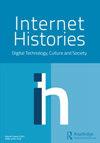Preserving the international museum of women: an interview with Marie Williams Chant
IF 1.2
Q3 COMMUNICATION
引用次数: 0
Abstract
AbstractIn the early days of the Web, the International Museum of Women emerged with the mission to highlight the achievements of women throughout history. Headquartered in San Francisco, the museum experimented with the rise of new digital technologies and evolved into a virtual museum with global outreach. Through innovative online approaches, they actively engaged communities around the world and gathered perspectives from a wide spectrum of visitors, whose voices were included in the exhibition narratives. In order to safeguard the museum’s legacy and its groundbreaking digital exhibitions, The Feminist Institute in New York launched a digital preservation initiative, working closely with the Global Fund for Women, a non-profit foundation that merged with the International Museum of Women in 2014. On July 31, 2023, we conducted an interview with Marie Williams Chant, Director of Archives and Special Projects, to delve into the museum’s historical significance. We also discussed their archival strategies and procedures, along with its potential impact on the museum’s legacies.Keywords: Web archivingonline museumsvirtual exhibitionsthe Feminist InstituteInternational Museum of Women AcknowledgementsWe like to thank Marie Williams Chant for her valuable insights and collaboration.Disclosure statementNo potential conflict of interest was reported by the authors.Notes1 The interview has been edited for improved readability and accuracy.2 The “California Woman Suffrage 1870-1911” exhibition opened in 1986 and was dedicated to women’s voting rights campaigns in California. The first public program of the International Museum of Women was dedicated to Sarah Wallis, pioneer of the Suffrage movement and the first President of the California Woman Suffrage Educational Association.3 “Imagining Ourselves: A Global Generation of Women” launched in 2006 was an award-winning exhibition online exhibition addressing the question What defines your generation of women? and featuring public submitted content from more than 100 countries globally.4 In addition, Social media also played a role developing collaborative exhibitions. The participants of Young Women Speaking the Economy used Facebook and other social media tools as a part of the exhibition’s development.5 ‘Mama: Motherhood around the globe’ launched in 2012 was an online exhibition dedicated to motherhood and maternal health.6 “IGNITE: Women fueling science & technology” in 2014 was a global media project explored the role of women in scientific and technological innovation. The Feminist Institute. “Storify” was a social media network platform open to the public from 2011 until 2018 allowing users to create stories or timelines by using content of other media sources such as Tweeter, Facebook or Instragram.7 Old Web Today (OldWeb.today) is an emulating system allowing users to browse the web (live web, current websites, web archives) through a variety of emulated browsers.8 Clara database of woman artists is an interactive database providing information on 18.000 women visual artists from all periods and nationalities.Additional informationNotes on contributorsIsmini KyritsisIsmini Kyritsis holds a master’s degree from Leiden University in Museums and Collections. Her master thesis “Rapid Response Collecting in times of COVID: A new path in museums identity?” explored how the extensive engagement with contemporary collecting during the COVID-19 pandemic has influenced the collecting activities of museums and possibly opened new prospects in their identity as social institutions. Her interests revolve around digital arts and culture as well as museum digital collecting and exhibition strategies.Karin de WildKarin de Wild is Assistant Professor in Contemporary Museum and Collection Studies at Leiden University (The Netherlands). Her research involves digital collections and the history of museums on the Web. Before joining Leiden University, she was a digital fellow in the “One by One” research at the University of Leicester (School of Museum Studies). She completed a Ph.D. in Digital Heritage at the University of Dundee (UK) and in her past life as curator and researcher, she collaborated with a wide range of museums including SFMOMA (US), Tate Modern (UK), the National Museum of World Cultures (NL) and the National Museums of Scotland (UK).保护国际妇女博物馆:采访玛丽·威廉姆斯·钱特
在网络的早期,国际妇女博物馆应运而生,其使命是突出历史上妇女的成就。总部设在旧金山的博物馆尝试了新数字技术的兴起,并发展成为一个具有全球影响力的虚拟博物馆。通过创新的在线方式,他们积极参与世界各地的社区,并从广泛的参观者那里收集观点,他们的声音被纳入展览的叙述中。为了保护博物馆的遗产和开创性的数字展览,纽约女权主义研究所(the Feminist Institute)与全球妇女基金会(Global Fund for Women)密切合作,发起了一项数字保护倡议。全球妇女基金会是一家非营利基金会,于2014年与国际妇女博物馆合并。2023年7月31日,我们采访了档案馆和特别项目主任玛丽·威廉姆斯·钱特(Marie Williams Chant),深入探讨了博物馆的历史意义。我们还讨论了他们的档案策略和程序,以及它对博物馆遗产的潜在影响。关键词:网络档案在线博物馆虚拟展览女权主义研究所国际妇女博物馆致谢我们要感谢玛丽·威廉姆斯·钱特宝贵的见解和合作。披露声明作者未报告潜在的利益冲突。为提高可读性和准确性,采访内容已经过编辑“加州妇女选举权1870-1911”展览于1986年开幕,专门展示加州妇女的投票权运动。国际妇女博物馆的第一个公共项目是献给莎拉·沃利斯的,她是选举权运动的先驱,也是加州妇女选举权教育协会的首任主席。2006年推出的“想象我们自己:全球一代女性”是一个屡获殊荣的在线展览,该展览解决了“是什么定义了你们这一代女性?”并提供来自全球100多个国家的公开提交内容此外,社交媒体也起到了发展合作展览的作用。“年轻女性谈论经济”的参与者使用Facebook和其他社交媒体工具作为展览发展的一部分。“妈妈:全球母亲”于2012年推出,是一个致力于母亲和孕产妇健康的在线展览2014年的“点燃:女性推动科技”是一个全球媒体项目,探讨了女性在科技创新中的作用。女权主义研究所。“Storify”是一个从2011年到2018年向公众开放的社交媒体网络平台,允许用户通过使用其他媒体来源(如twitter, Facebook或instagram)的内容来创建故事或时间轴。7 OldWeb Today (OldWeb.today)是一个模拟系统,允许用户通过各种模拟浏览器浏览网络(实时网络,当前网站,网络档案)Clara女性艺术家数据库是一个交互式数据库,提供来自各个时期和国籍的18,000名女性视觉艺术家的信息。ismini Kyritsis拥有莱顿大学博物馆与收藏专业硕士学位。她的硕士论文《COVID时代的快速反应采集:博物馆身份的新路径?》,探讨了COVID-19大流行期间与当代收藏的广泛接触如何影响博物馆的收藏活动,并可能为博物馆作为社会机构的身份开辟新的前景。她的兴趣主要集中在数字艺术和文化,以及博物馆的数字收藏和展览策略。Karin de Wild,荷兰莱顿大学当代博物馆与收藏研究助理教授。她的研究涉及数字收藏和网上博物馆的历史。在加入莱顿大学之前,她是莱斯特大学(博物馆研究学院)“一对一”研究项目的数字研究员。她在英国邓迪大学完成了数字遗产博士学位,在她作为策展人和研究员的过去,她与许多博物馆合作,包括SFMOMA(美国),泰特现代美术馆(英国),世界文化国家博物馆(NL)和苏格兰国家博物馆(英国)。
本文章由计算机程序翻译,如有差异,请以英文原文为准。
求助全文
约1分钟内获得全文
求助全文

 求助内容:
求助内容: 应助结果提醒方式:
应助结果提醒方式:


